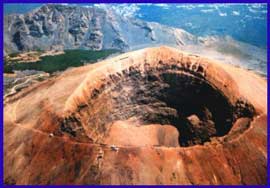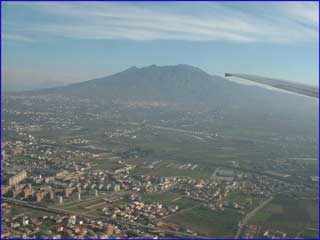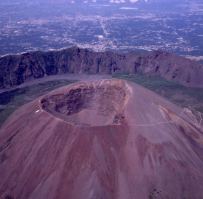





















 |
 Mt.
Vesuvius is the best known volcano on earth; it dominates the Bay of Naples with
its characteristic cone. It is a typical example of a volcano in a volcano made
by an outer broken cone, Mt. Somma (1133 metres) with a crateric belt most of
which is destroyed. In it there is a smaller cone, the Mt. Vesuvius (1281 metres),
divided by lowering named Valle del Gigante (Giants Valley), a part of the
ancient caldron where in a later period, perhaps during the 79 A.D. eruption,
the Gran Cono (Great Cone) or Mt. Vesuvius arose. The Valle del Gigante is still
divided in Atrio del Cavallo on the west and the Valle dell'Inferno on the east.
The Somma's ancient crater is well preserved as far as its entire northern part
is concerned, in fact in historic times it was less exposed to the volcano's
devastating violence, because it was well protected by the height of the
internal face that has prevented the downflow of lava on its slopes. The slopes,
which vary in their steepness, are furrowed by profound radial grooves
produced by the erosion of the meteoric waters. The whole section is then
characterized by dikes and fringes of dark volcanic rock. The old crater edge is
a stream of summits called cognoli. While the height of mount Somma and its
profile have remained the Mt.
Vesuvius is the best known volcano on earth; it dominates the Bay of Naples with
its characteristic cone. It is a typical example of a volcano in a volcano made
by an outer broken cone, Mt. Somma (1133 metres) with a crateric belt most of
which is destroyed. In it there is a smaller cone, the Mt. Vesuvius (1281 metres),
divided by lowering named Valle del Gigante (Giants Valley), a part of the
ancient caldron where in a later period, perhaps during the 79 A.D. eruption,
the Gran Cono (Great Cone) or Mt. Vesuvius arose. The Valle del Gigante is still
divided in Atrio del Cavallo on the west and the Valle dell'Inferno on the east.
The Somma's ancient crater is well preserved as far as its entire northern part
is concerned, in fact in historic times it was less exposed to the volcano's
devastating violence, because it was well protected by the height of the
internal face that has prevented the downflow of lava on its slopes. The slopes,
which vary in their steepness, are furrowed by profound radial grooves
produced by the erosion of the meteoric waters. The whole section is then
characterized by dikes and fringes of dark volcanic rock. The old crater edge is
a stream of summits called cognoli. While the height of mount Somma and its
profile have remained the same for centuries, the height and the profile of the mount Vesuvius have
suffered considerable variation, because of the following eruptions, with
raisings and lowerings. Mt. Vesuvius is a characteristic polygenic mixed volcano,
meaning that it is constituted by lava of different chemical composition (for
example trachytes, tephrites, leucitites) and formed either by casting of lava
or pyroclastic deposits. All the zones at the slopes of the mountain are formed
by transported earth of lava mud which goes down from the steep slopes in the
rainy seasons through deep and narrow grooves called channels or more commonly
"lagni". The high embankments are formed by piles of lavic scoriae,
which precipitated in incandescent state and spread towards the low slopes,
proving precious for the vegetation thanks to their fertile material, rich in
silicon and potassium. Proceeding along the rim of the crater, one can observe
the whole extent of the southern part of the volcano and, during days with good
visibility, it is possible to see the entire gulf of Naples, from the Sorrento
peninsula to Cape Miseno, Procida and Ischia. It is also possible to note the
large number of buildings which have been built on the vulnerable flanks of the
mountain.
same for centuries, the height and the profile of the mount Vesuvius have
suffered considerable variation, because of the following eruptions, with
raisings and lowerings. Mt. Vesuvius is a characteristic polygenic mixed volcano,
meaning that it is constituted by lava of different chemical composition (for
example trachytes, tephrites, leucitites) and formed either by casting of lava
or pyroclastic deposits. All the zones at the slopes of the mountain are formed
by transported earth of lava mud which goes down from the steep slopes in the
rainy seasons through deep and narrow grooves called channels or more commonly
"lagni". The high embankments are formed by piles of lavic scoriae,
which precipitated in incandescent state and spread towards the low slopes,
proving precious for the vegetation thanks to their fertile material, rich in
silicon and potassium. Proceeding along the rim of the crater, one can observe
the whole extent of the southern part of the volcano and, during days with good
visibility, it is possible to see the entire gulf of Naples, from the Sorrento
peninsula to Cape Miseno, Procida and Ischia. It is also possible to note the
large number of buildings which have been built on the vulnerable flanks of the
mountain.
The
eruptions
The
eruption of the 79 A.D.
The
eruption began on 24 August of the 79 A.D. towards noon. The first eruptive
phase was characterized from strong "freatomagmatiche" outbreaks.
After this phase, magmatic outbreaks were followed until the morning of the
following day, feeding a column constituted mostly from gas, pomici and ashes
that were raised until 30 kilometers. The high part of the column expanded, assuming the shape of a pine, and was pushed from the twenty
towards south-east. The contained particles in it often fell to the ground,
forming a layer of pomici that to Pompei and Oplonti caught up 2-3 m. of
thickness. Partial collapses of the eruptive column generated piroclastic flows
that noticed to high long speed the flanks of the volcano, caught
column expanded, assuming the shape of a pine, and was pushed from the twenty
towards south-east. The contained particles in it often fell to the ground,
forming a layer of pomici that to Pompei and Oplonti caught up 2-3 m. of
thickness. Partial collapses of the eruptive column generated piroclastic flows
that noticed to high long speed the flanks of the volcano, caught  up
and destroyed Ercolano. The city of Pompei, the much farthest one, did not come
caught up and the greater part of its inhabitants survived. During the last
hours of the night the intensity of the eruptive activity diminished. up
and destroyed Ercolano. The city of Pompei, the much farthest one, did not come
caught up and the greater part of its inhabitants survived. During the last
hours of the night the intensity of the eruptive activity diminished.
At the first hours in the 25 morning, a "freatomagmatica"
outbreak generated piroclastici, turbulent flows - terrible "the base-surge
" - that, travelling at the speed of a hurricane, came down along the
slopes of the volcano, devastated the surrounding areas until distances of 15
kilometers and caused numerous victims also between the inhabitants of Pompei
that were survivors to the first phase of the eruption. In the course of the day
the outbreaks diminished of intensity and, in evening stopped of all, leaving
one large pall of ashes and pomici on the huge area. The abundant rains,
provoked also from the breaking in in the atmosphere of enormous fine particle
and vapor amounts, mobilized this material, forming dense mud taps that came
down from the flanks of the volcano and of the Appennine relieves along it goes
them to them, ulteriorly having the territory of the vesuvian area.
The eruption of 1631
The
eruption of 1631 has been most violent and destructive of the history of the
Vesuvio in the last millenium. After along period of quiescence, approximately 5
centuries, preceded from one series of premonitory phenomena, which earthquakes
and raisings of the ground, the volcano waked causing the death of approximately
6.000 persons and the devastation of an area nearly 500 km. 2
The eruption began at the 7 in the morning of 16 December, with the formation of
an eruptive column of approximately 15 km., from which they began to fall pomici
and ashes in the area to east of the Vesuvio. At the 10 in the morning of 17
December, from the central crater generated piroclastici flows, gas clouds
loaded with magma fragments that, sliding to long high velocity the flanks
western and southern of the volcano, they destroyed all that they met in their
way. In the night between the 16 and the 17, and in the afternoon of the 17, the abundant rains mobilized
the incoherent ash cover causing the formation of mud taps. The taps came down
from the flanks of the volcano, from the slopes of the Appennine to
north and the northeast.
the 16 and the 17, and in the afternoon of the 17, the abundant rains mobilized
the incoherent ash cover causing the formation of mud taps. The taps came down
from the flanks of the volcano, from the slopes of the Appennine to
north and the northeast.
The phase of paroxysm in the eruption lasted three days, provoking an
enormous panic between the population. There were on the roads of Naples public
confessions of sins, accompanied from extraordinary manifestations of penance,
and were organized processions with the statue and the blood of S. Gennaro, so
that the patron appease that divine temper of which the outbreak of the Vesuvio
it seemed the indubitabile sign.
The Count of Monterrey, viceroy of Naples from January of that year, sent
some ships to collect the survivors of Torre del Greco and Torre Annunziata.
After some months, deeply upsetting from the event, it made to affix in Portici
a tablet that it exhorts the descendants not to forget the nature about
the mountain, and to recognize ready the premonitory ones of a volcanic eruption.
The eruption of 1944
On
18 March of 1944, during the occupation of the allied troops, began the last
eruption of the Vesuvio, that concluded a period of activity begun in 1914,
during which it had been taken place the only modest eruptions from the central
crater .
Between 1914 and 1944, lave and the slag produced from the volcano had filled up
crater, wide 720 m. and deep 600 m., than it had been formed during the previous
eruption of 1906.
A little cone of slag it emerged from the crater.
13-17 March
The little cone of slag it begins to collapse and the sismic activity becomes
more intense. A new slag cone born and collapsed again.
18 March
The eruption begins in the afternoon with slag launch. At the 16,30 a lavic
strained overflowed from the northern part of the crater and catches up the
Valle dell'Inferno at the 22.30. Nearly at the same time an other tap overflows
from the southern part of the crater. At the 23 there was also a spillage
of washes from the western part of the crater: the tap follows the railroad of
the funicular and interrupts the railroad.
19 March
At the 11 the washes flows along the Fosso della Vetrana.
20 March
Between the afternoon and the night, new strained overflowed from the northern
part of the crater. All the effusive activities are accompanied by sismic tremor
with increasing amplitude until half of the day.
21 March
 The
southern tap arrests at a quota approximately 300 m. on the sea level. In the
night, the northern tap catches up S. Sebastiano and Massa di Somma and is
divided in two coppers that are left over in direction of Cercola, from which in
evening they are distant approximately 1,5 km. S. Sebastiano and Massa di Somma
come evacuate and the 10,000 inhabitants transferred to Portici. Around
the 17, the spectacular fountains of wash begin to form, the last of which hard
approximately 5 hours and catch up a height nearly 1,000 m. Fragments of wash
and ashes moved from the winds in quota, are deposited on the Southeastern
areas of the volcano, between Angri and Pagani. The smaller fragments catch up
distances than beyond 200 km. towards south-east. Slag until a kilogram of
weight catch up the city of Poggiomarino, at approximately 11 km. from the
crater. Great still warm slag amounts are accumulated on the flanks of the Great
Cone. The sismic tremor continues, with maximums of amplitude in coincidence
with the emission of the fountains of wash. The
southern tap arrests at a quota approximately 300 m. on the sea level. In the
night, the northern tap catches up S. Sebastiano and Massa di Somma and is
divided in two coppers that are left over in direction of Cercola, from which in
evening they are distant approximately 1,5 km. S. Sebastiano and Massa di Somma
come evacuate and the 10,000 inhabitants transferred to Portici. Around
the 17, the spectacular fountains of wash begin to form, the last of which hard
approximately 5 hours and catch up a height nearly 1,000 m. Fragments of wash
and ashes moved from the winds in quota, are deposited on the Southeastern
areas of the volcano, between Angri and Pagani. The smaller fragments catch up
distances than beyond 200 km. towards south-east. Slag until a kilogram of
weight catch up the city of Poggiomarino, at approximately 11 km. from the
crater. Great still warm slag amounts are accumulated on the flanks of the Great
Cone. The sismic tremor continues, with maximums of amplitude in coincidence
with the emission of the fountains of wash.
22 March
Towards the 1 p.m. the eruption was in its maximum activity. A column of
gas and ash rises at a 6 Km. of height. Ashes and slag fall on the
south-eastern slope of the volcano. A big seismic tremor accompanies all the
phase, during which the crater becomes wide.
23 March
A series of explosions are caused by the entrance of water in the volcanic duct
and there was a swarm of earthquakes.
29 March
The eruption end. It caused the death of some persons, the collapse
of the roofs and serious damages in S. Sebastiano and Massa di Somma.
|
